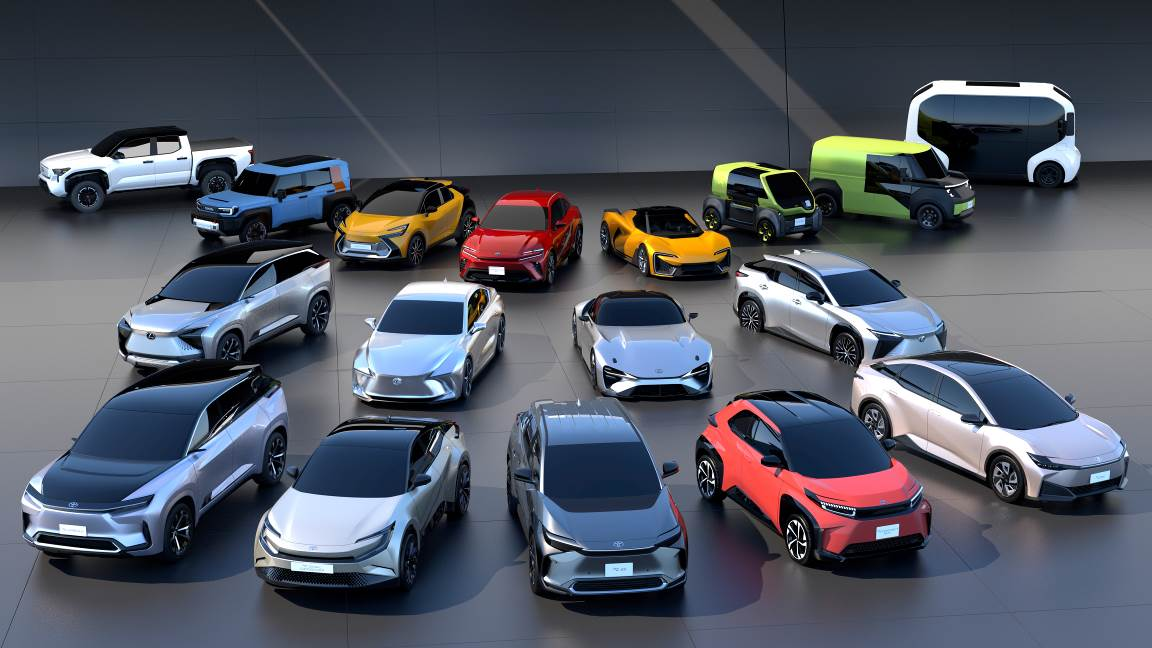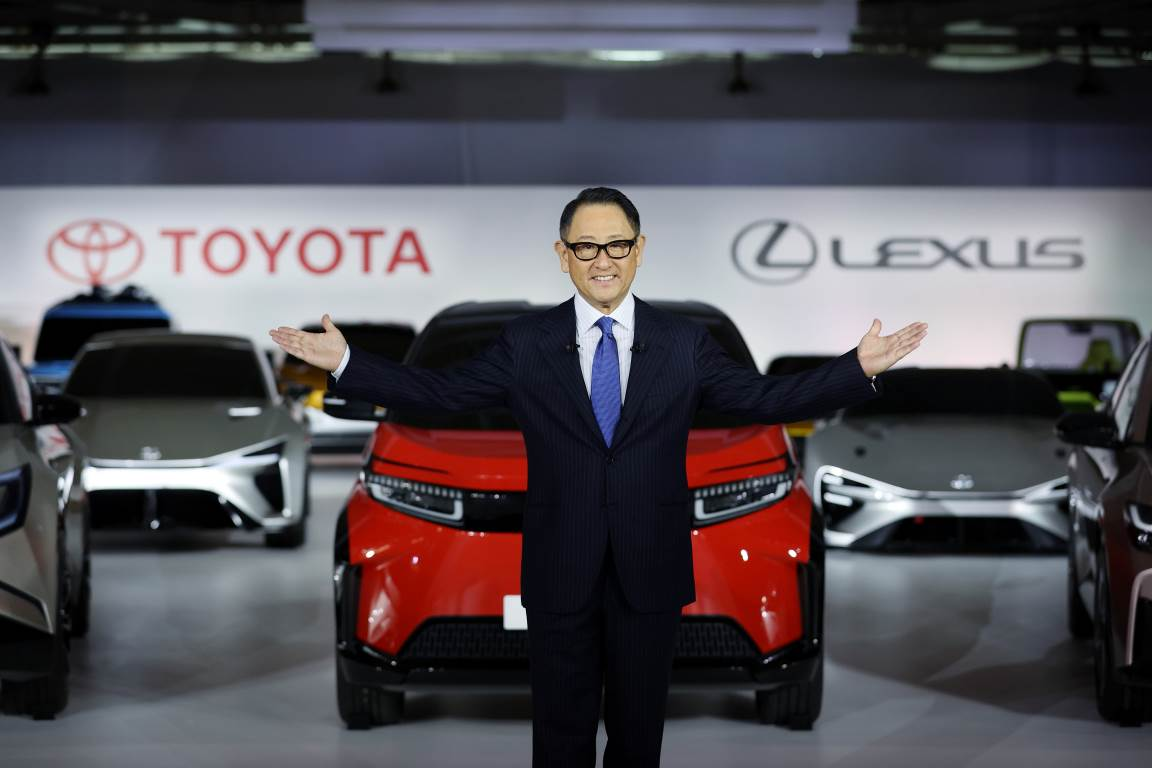The Four Modernizations of the Automotive Industry: Toyota’s Response to Carbon Neutrality
The automotive industry is facing a transformational shift unseen in a century, as the global wave of the four modernizations of automobiles surges forward. Everyone involved in the industry must be wondering what the future holds in terms of travel and the industrial supply chain.
The world’s largest automaker, Toyota, has its own answer. On December 14th, Toyota President Akio Toyoda transformed MEGA WEB into a showcase for the future, unveiling the BEV Show, which lays out Toyota’s plans for achieving carbon neutrality.
By importing BEV models, Toyota plans to introduce 30 BEV models by 2030, offering a comprehensive range of products across various fields, including passenger cars and commercial vehicles, worldwide. By 2030, Toyota plans to reach annual global sales of 3.5 million BEV units, with an expected investment of 4 trillion yen by that time.
At the press conference, a large number of electrified new car products were showcased, igniting the industry and consumers alike.
This is no longer the conservative Toyota that some had thought to be hesitant about electrification. While Toyota was initially slow to enter the EV field, it was once labeled as a “conservative” in terms of electrification by some media and industry insiders.
But this time, Toyota has shown its hand, with a balanced attitude between “conservative” and “radical,” which has caught many people off guard. But upon closer analysis, it is not a surprise given Toyota’s usual style of accumulating quietly and achieving success steadily.
One of the reasons behind Toyota’s strategic adjustment is, without a doubt, carbon neutrality.
Around the world, the journey towards carbon neutrality has just begun. From a timetable initially set at the policy level to the response from industry giants, this process is bound to be lengthy, likely taking a decade or even two.
However, from the information given by Toyota, it is apparent that Toyota has a very clear approach and plan for every step towards carbon neutrality.
Sharpen Your Tools Before Cutting Wood: Accumulating Is More Important Than Hurrying
In the face of extreme weather and climate change, countries worldwide are actively discussing solutions. “Carbon neutrality” has become a global consensus, with more and more countries and regions realizing its urgency and developing clear plans and objectives.
After China set its goal of carbon peak and carbon neutrality, it issued the “Opinions on the Complete, Accurate and Comprehensive Implementation of the New Development Philosophy to Achieve Carbon Peak and Carbon Neutrality” and the “Carbon Peak Action Plan by 2030.” These policies are shaping a “1+N” policy system for carbon peak and carbon neutrality, with clear timetables, roadmaps, and construction plans.
Against this backdrop, as one of the largest greenhouse gas emitters, the automobile industry is taking action to explore a path to reduce carbon emissions and help achieve the “dual carbon” goals. Toyota is one of the representatives in this regard. In fact, as a global automaker with millions of units, Toyota has always had profound reserves in the field of environmental protection.
As early as 2015, Toyota had released its “Toyota Environmental Challenge 2050” strategy, which aimed to make the negative impact of vehicles approaching zero and bring positive energy to society. The goal is to reduce CO2 emissions by 90% during the average global new car journeys by 2050, compared to 2010.
Currently, the Toyota brand has introduced around 100 models in over 170 countries and regions, including petrol cars, hybrid cars, plug-in hybrid cars, and hydrogen fuel cell cars. The Lexus brand has introduced around 30 models in over 90 countries and regions, including petrol cars, hybrid cars, and plug-in hybrid cars. In the future, Toyota will continue to expand the range of “carbon-neutral vehicles” by importing BEV models.
As promised by Toyota, it is expected to introduce 30 BEV models by 2030 and provide a full range of products in various fields, including passenger cars and commercial vehicles globally. The global BEV annual sales plan is expected to reach 3.5 million vehicles by 2030.
In addition, Toyota also announced that the Lexus brand is expected to achieve a full range of products with BEV versions for all models by 2030, and achieve 100% BEV model sales in China, North America, and Europe, with a goal of global sales of 1 million units. By 2035, 100% sales of BEV models will be achieved globally.
For Toyota, which has the usual cautious style, from the accumulation in the past to the current comprehensive momentum, its layout ideas and action trajectory just fit an old Chinese saying “sharpen the knife and do not miss chopping wood”. Compared with rushing to catch up with the electric trend temporarily, this is a more sensible choice.
In fact, if we look back at the past electrification initiatives, Toyota has actually paved the way and tested the waters for this electrification layout.
In September 2019, Toyota signed a strategic cooperation framework agreement with GAC, deepening cooperation in the field of electric vehicles and intelligent network connection, including new energy vehicles. In addition to launching hybrid cars and plug-in hybrid cars loved by Chinese consumers, it will also focus on launching cost-effective pure electric vehicles, hydrogen fuel cell vehicles, and other models to meet the diverse needs of Chinese consumers and promote the research and popularization of electric vehicles in China.
Toyota’s future plan for this layout not only means that it hopes to respond to all situations and demands in various countries and regions and provide diversified choices to achieve carbon neutrality, but also its positive response to global climate change in an all-round electrification manner.
If there is still no correct answer, then provide diversified choices.# Carbon Neutrality: Toyota’s Approach
Carbon neutrality is a grand vision. Is there only one path to achieve this goal? Toyota’s actions suggest that perhaps we can think differently.
Toyota believes that carbon dioxide is the biggest enemy to achieving carbon neutrality. As such, the Japanese automaker hopes to provide consumers with a variety of sustainable transportation services and products that balance practicality and sustainability. Consumers can choose travel services and products according to different regions, purposes, and usage scenarios.
The practice of carbon emissions ultimately falls on each new car. Toyota believes that electrified vehicles can be divided into two types based on the energy they use.
One type is the “Carbon Reduction Vehicle” that can reduce carbon dioxide emissions. If the energy used to power the vehicle is not green and environmentally friendly, then no electrified vehicle can achieve zero carbon dioxide emissions. Therefore, this type of vehicle is called a “Carbon Reduction Vehicle.”
The other type of electrified vehicle is called the “Carbon Neutral Vehicle,” which emits zero CO2 emissions. Even if an internal combustion engine is used, carbon neutrality can still be achieved if pure green energy is used.
Unlike other car companies that focus solely on electric vehicles (EVs), Toyota insists on a comprehensive approach to electrification. Toyota actively promotes the progress and popularization of Hybrid Electric Vehicles (HEVs), Plug-in Hybrid Electric Vehicles (PHEVs), Electric Vehicles (EVs), and Fuel Cell Electric Vehicles (FCEVs) to provide consumers with diversified choices.
As early as 1993, Toyota launched the G21 project, proposing to produce “cars required by the earth in the 21st century.” In 1997, Toyota produced the world’s first mass-produced hybrid electric vehicle, the Prius.
According to Toyota’s statistics, the company has sold more than 18 million HEVs globally, which is equivalent in battery capacity to about 260,000 EVs. However, the carbon dioxide reduction effect is equivalent to about 5.5 million EVs.
“Toyota is committed to working together as a company towards carbon neutrality. As an international company committed to offering a comprehensive product lineup, we will provide diversified solutions according to each country’s energy situation. The choice of which product to choose is not Toyota’s decision, but the market and consumers’ decision,” said Akio Toyoda. We hope to offer consumers as many options as possible until the correct route to carbon neutrality becomes apparent.
This means that Toyota wants to face uncertain times with various solution methods because there is no right answer.Satoshi Ogiso, CBO of Toyota, stated that “carbon neutrality is closely related to energy security. It is necessary to consider the energy situation of each region, the methods of car use by consumers, and actual needs in a balanced manner.”
For example, it is necessary to consider the entire lifecycle of cars from “production” to “transportation” and then to “use”, as the usage environment of cars varies by region. In areas such as the United States and Europe where long-distance travel is required, or in regions such as Japan where the average driving distance is relatively short, the impact of the “use” phase on the lifecycle varies by region, requiring comprehensive consideration of these factors to create and introduce the best combination.
According to Akio Toyoda, depending on the energy situation, importing BEV vehicles to areas without charging equipment is inconvenient for consumers. From a global perspective, diverse solutions are needed in diverse markets and environments.
In Toyota’s all-round electrification strategy, HEVs and PHEVs (plug-in hybrid electric vehicles) will continue to develop and contribute in the future. As China has a vast land area and significant differences in climate conditions and vehicle usage environment, the future energy structure in China will not be solely based on EV electrification.
Every link should give it their all
To truly achieve “carbon neutrality,” it ultimately depends on all aspects of our daily lives.
It is well known that the automobile industry must reduce carbon dioxide emissions from all aspects, from vehicle production to use and recycling, to achieve carbon neutrality. Therefore, Toyota chooses to start from the perspective of the entire lifecycle, and through its own efforts and innovative practices, it reduces carbon dioxide emissions from manufacturing, storage, use, recycling and reuse, and waste treatment.
At the same time, Toyota is also contributing towards carbon neutrality in China through the LCA perspective. Specific measures include promoting CO2 reduction in new factories and R&D, reducing waste, and using green electricity. In 2020, CO2 emissions per unit produced in factories decreased by 46%, and waste decreased by 88% (compared to 2006). In core dealerships, Toyota promotes the use of green electricity and energy-saving measures to approximately 1,500 dealerships nationwide. Toyota is also developing the recycling and reuse of used batteries, aiming to “prevent any battery from causing pollution,” and more.
In this process, adhering to the concept of being rooted in the local area and becoming the best company locally, Toyota is also seeking to cooperate with like-minded Chinese companies.
Taking hydrogen fuel cell technology as an example, on the usage side, Toyota has jointly developed a high-power and long-lasting hydrogen fuel cell system TL Power 100 suitable for commercial vehicles’ usage environment in China with a Chinese partner. In terms of recycling and reuse, Toyota and Chinese companies have begun to cooperate in researching appropriate disposal methods and resource recycling of core components of FCEV scrapped vehicles.In the process of promoting industry-wide carbon neutrality, Toyota has continued to carry out a series of social welfare activities centered around core areas such as “environmental protection, traffic safety, and talent development” to contribute to society. Among them, in the field of environmental protection, Toyota has successively launched the Fengning afforestation project and the Toyota Longhua sustainable development rural project, making important contributions to local environmental protection.
With a combination of measures, Toyota is taking a full-life-cycle approach, and is engaging in extensive and in-depth cooperation through the advancement of technology and the popularization of renewable energy.
“Toyota is actively working towards carbon neutrality. In a world with no right answers, Toyota hopes to have a diversified selection to meet the challenges, and we are doing our best for each option,” said Akio Toyoda.
This article is a translation by ChatGPT of a Chinese report from 42HOW. If you have any questions about it, please email bd@42how.com.
